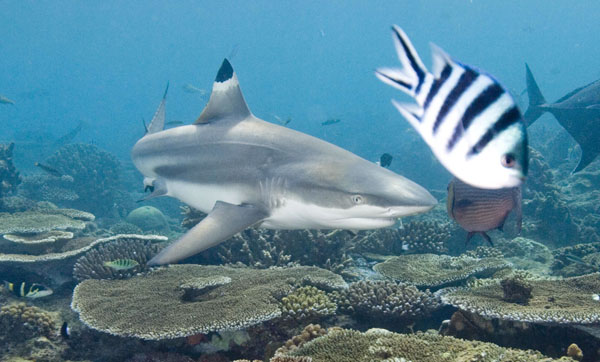 |
| Picture taken by Mary O'Malley at Tahiti. Image obtained from http://www.sharksavers.org/en/blogs-news/community-voice/the-social-life-of-sharks/ [i] |
At a glance...
Table of Contents
As a city-state which has undergone much urbanisation, Singapore is generally not regarded to possess high ecological value. Nevertheless, sightings of charismatic organisms suggest that the situation might not be as dire. Of these organisms, few have evoked as wide a range of emotions as the shark. This page therefore seeks to highlight a shark which can be found in Singapore -- the Carcharhinus melanopterus (blacktip reef shark).
The blacktip reef shark is currently listed under the IUCN (International Union for Conservation of Nature) as "near threatened" [1], with main threats arising from the sharksfin trade as well as fishing activities. Although the shark population in Singapore is too small to support shark-fishing industries, sharks are locally being removed through entanglement in fishing nets, through environmental degradation which damages trophic relationships, or as accidental catch by hobby fishermen. The removal of sharks from an already depleted population can only further deteriorate coastal ecosystems which are presently already under severe anthropogenic pressures.
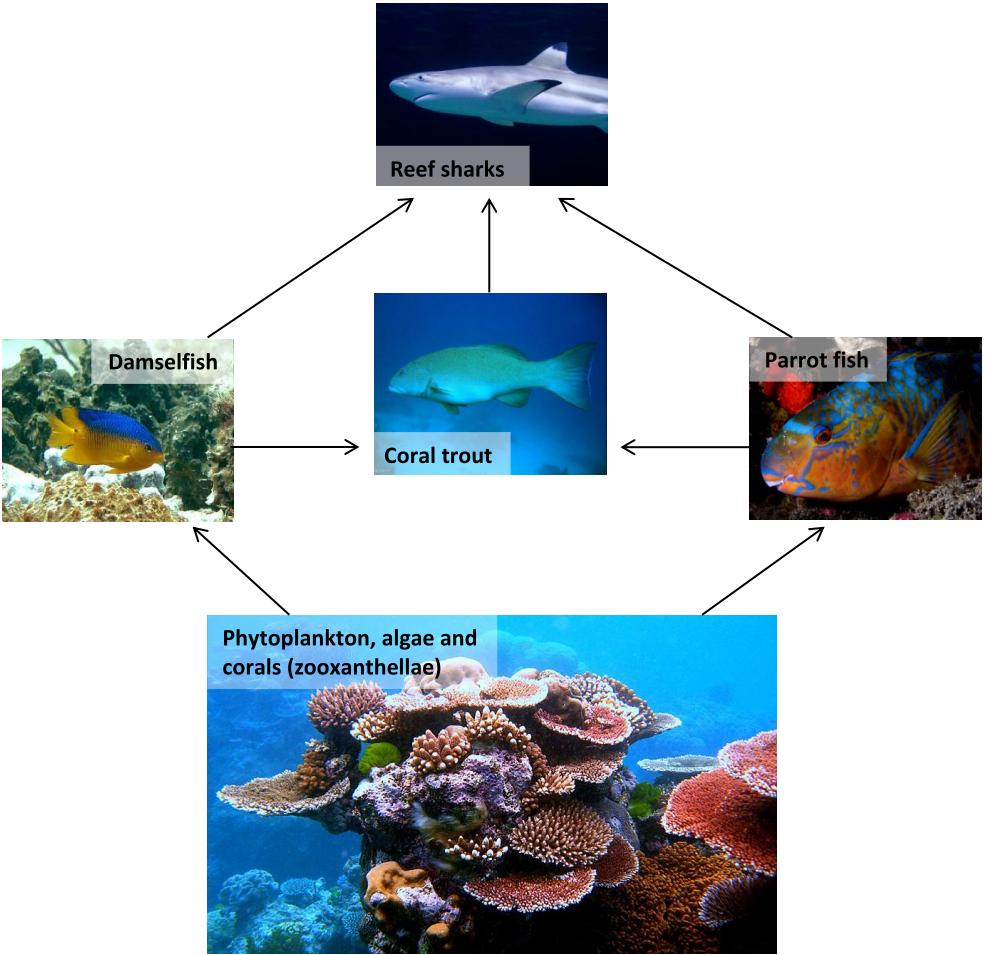 |
| Simplified food web depicting the position of reef sharks in a coral reef ecosystem. All images were obtained from Wikimedia commons. |
Relevance to Singapore
Sharks in Singapore
"Shark" very loosely refers to a wide range of organisms which can include dogfishes, rays and even catfishes. The term is therefore not well-defined. Nevertheless, using vernacular common names as a search term, 4 species of sharks have been recently observed in Singapore [2] - [3].- Blacktip reef shark (Carcharhinus melanopterus) -- of course!
- Slender bamboo shark (Chiloscyllium indicum)
- Singapore coral cat shark (Atelomycterus maromaratus)
- Bull shark (Carcharhinus leucus)
Local encounters with sharks have been rare. The recent sightings have been of sharks which have been killed by fishing and other human activities. Shark attacks are even more rare in Singapore. Since records began to be kept, 4 shark attacks have been observed with 3 being fatal. The last fatal encounter was recorded in 1954 [4].
Sightings of the blacktip reef shark
Singapore does not have strong research focused on shark ecology. Nevertheless, there have been sightings of the blacktip reef shark over the years. These sharks have been spotted near the coral reefs around the Southern offshore islands (see image below). It is hence reasonable to posit that the fate of blacktip reef shark communities in Singapore is intertwined with the fate of coral reefs in Singapore.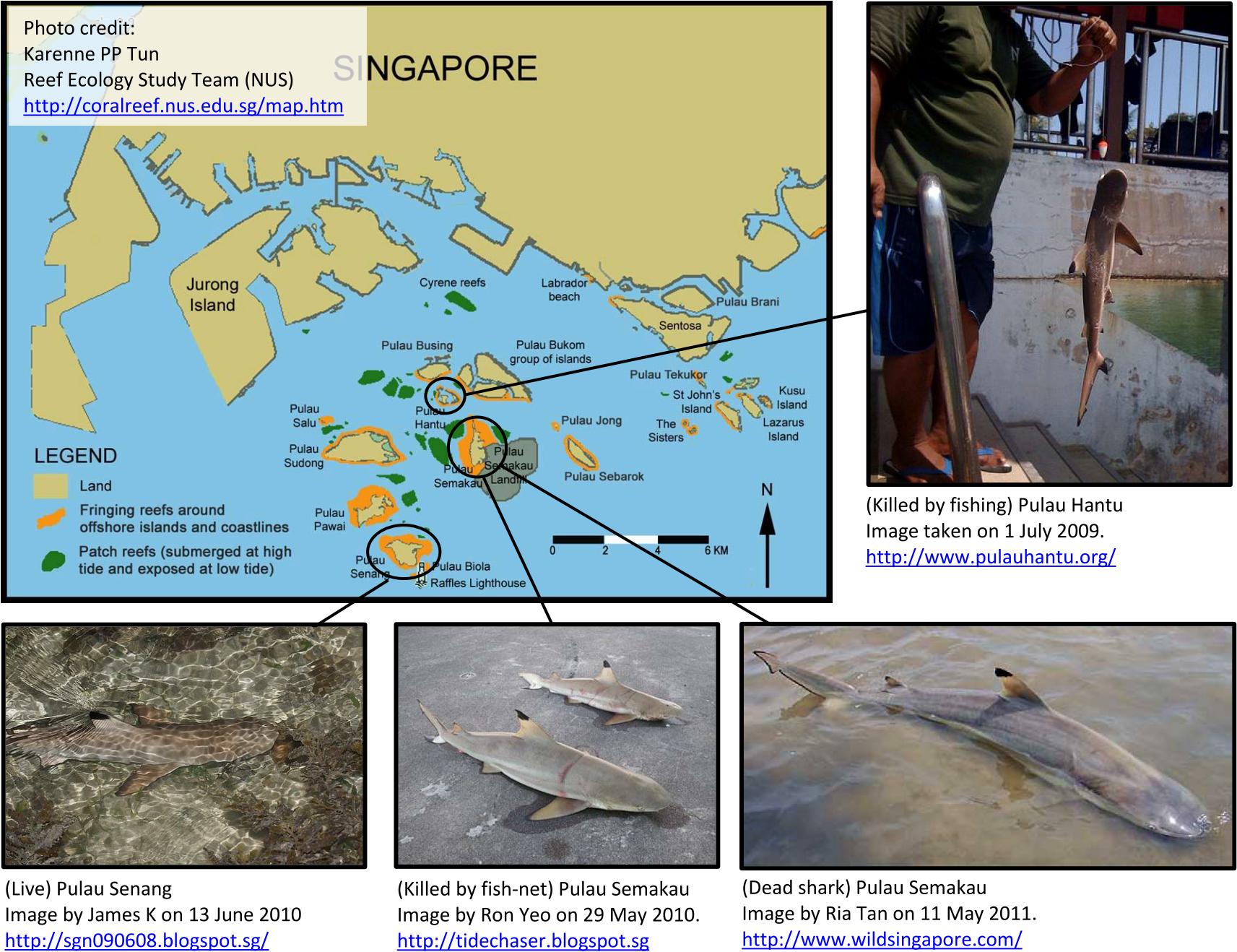 |
| Recorded sightings of blacktip reef sharks over the years [ii] - [vi] |
Sharksfin trade
Singapore does not have a shark population that is large enough to support shark-fishing industries. Nevertheless, Singapore is a very significant node in the global trade of sharksfin and is second only to Hong Kong [5]. The depletion of shark populations all over the world is likely to lead to devastating trophic cascades. In particular, declining reef shark populations have been observed to be an important cause of coral reef degradation (see video).Coral reef systems provide a wide variety of services. It has been found to increase the abundance and health of fish populations, and can also protect shorelines from wave erosion. Such benefits are often poorly quantified, and can lead to inaccurate assumptions that the economic benefits derived from the sharksfin trade is easily justifiable. It is therefore important for the public to be educated about the costs of such actions as well.
In particular, if charismatic organisms like sharks can be used to capture the attention of the Singapore public, then it could provide a platform for people to learn about what they stand to lose. After all, it is often only when people are able to gauge how much they truly possess that they can then properly also become aware of how much they can truly lose.
Identification
Common names
There are communities particularly in Hawaii who believe that sharks embody the spirits of their ancestors [6]. There is hence an emotional and spiritual connection between human communities and sharks. The blacktip reef shark, which is found in close proximity to many of these communities, therefore have many vernacular names. Languages from the Southeast Asian region are presented here.
Characteristic features
The blacktip reef shark is most easily recognised by colouration particularly of the dorsal fin. Dorsal fins are black at the tip with a white patch below. This feature was so characteristic that when Jean René Constant Quoy and Joseph Paul Gaimard first described it in 1824, they named it a melanopterus. The word which derives from two Greek words – melas, meaning “black”; and pteron, meaning “wing” or “fin”. This feature is often diagnostic, but there is one other shark species which presents with black colourations on its dorsal fin.Blacktip oceanic sharks (Carcharhinus limbatus) are found in the pelagic open seas and also has black colouration at the tips of its fins. They are often mistaken for blacktip reef sharks. The most significant differences are:
- Differences in habitat ranges -- C. melanopterus tend to be found around coral reef whereas C. limbatus tend to be found in the pelagic open seas.
- The shape of their snout -- C. limbatus tend to have a sharper snout whereas C. melanopterus tend to have a blunter snout.
- Pattern of dorsal fin colouration -- C. limbatus lacks a patch of white just beneath the black colouration at the tip of the dorsal fin.
 |
| Comparison between a blacktip reef shark and a blacktip oceanic shark. Images obtained from Wikimedia commons. |
Some additional characteristics of the blacktip reef shark are presented in the figures below.
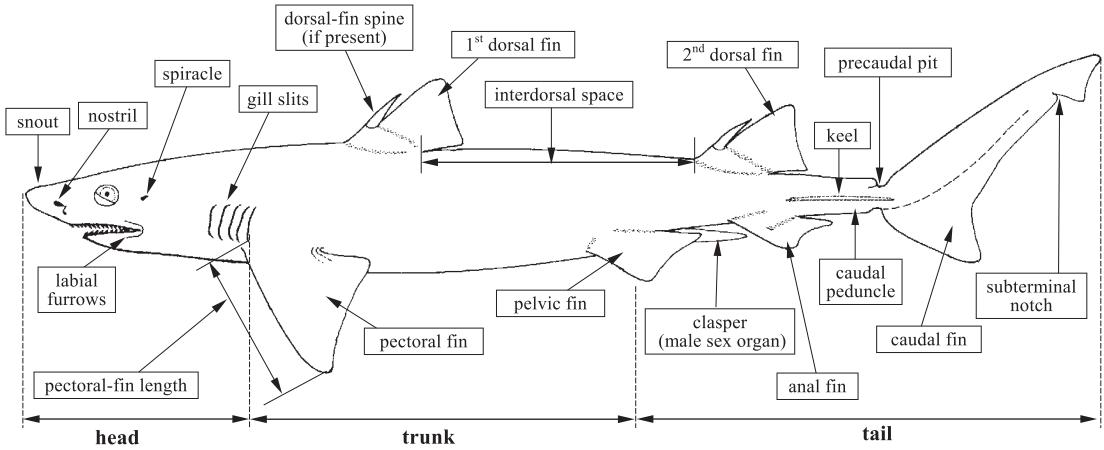 |
| Image from FAO Identification Guide [vii] |
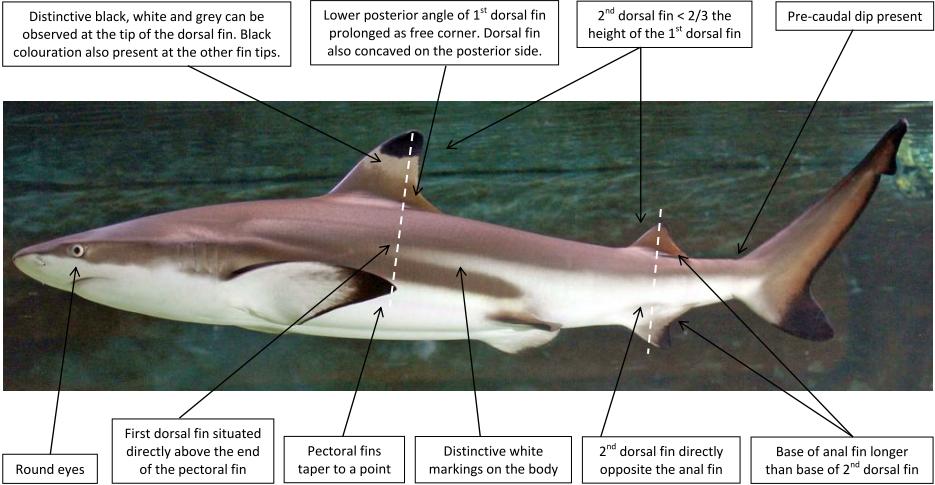 |
| Image obtained from http://www.ryanphotographic.com/carcharhinidae.htm [viii]. Labels manually inserted. |
Some distinguishing features between males and females [7]:
- The presence of claspers which are male sex organs. Claspers are cartilaginous extensions of the pelvic fin, and typically present as a pair
- Adult females (0.97 - 1.12 metres) tend to be slightly larger than adult males (0.91 - 1.0 metres), but there is overlap between the two ranges
- Males tend to have more sharply curved teeth than the females, but this characteristic is not properly quantified
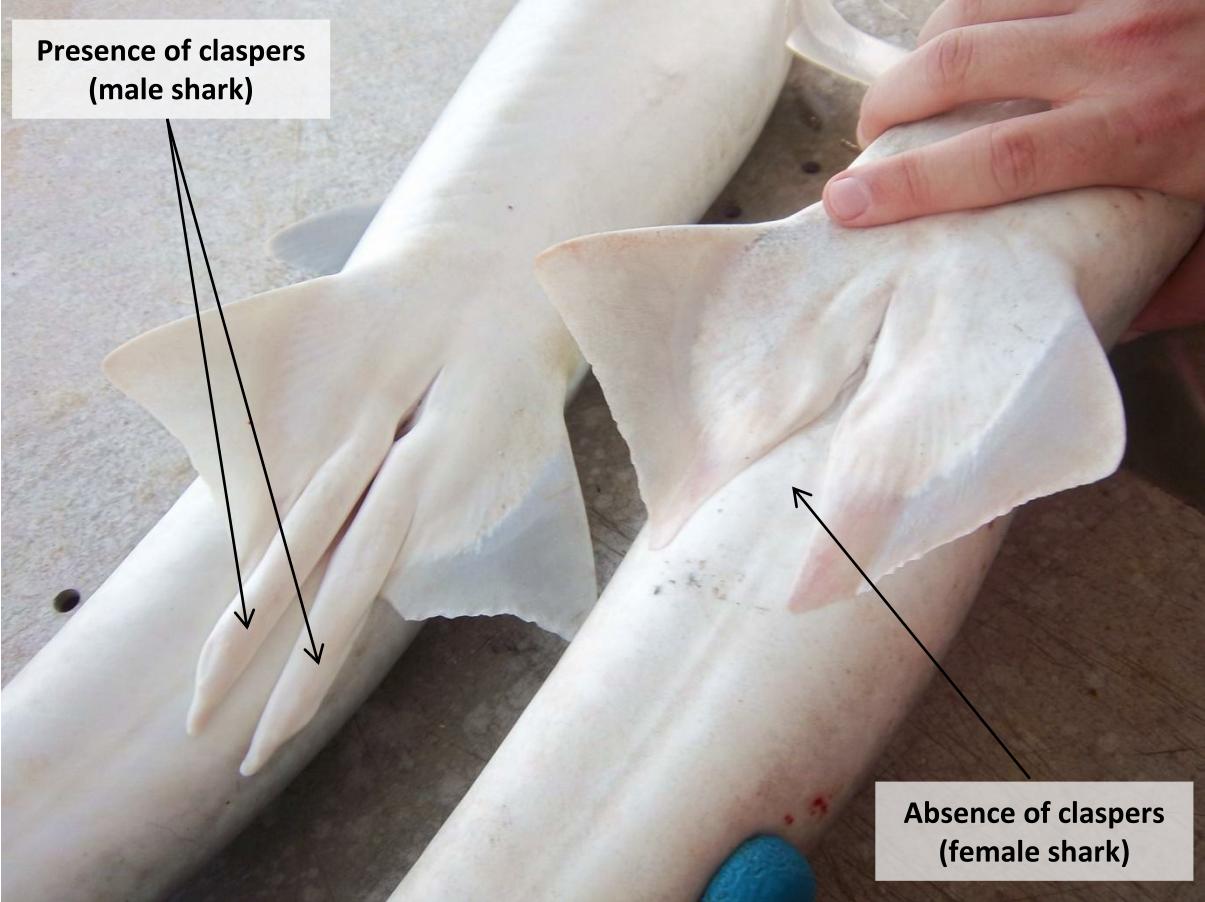 |
| Presence or absence of claspers on ventral portions of male (left) and female (right) sharks. Image taken by Jennifer Goldner, NOAA (National Oceanic and Atmospheric Administration). Image hosted at http://teacheratsea.wordpress.com/ [ix]. Labels manually inserted. |
Ecology and Behaviour
Geography
Blacktip reef sharks are typically found in the same habitat as the Grey Reef Shark (Carcharhinus amblyrhynchus) and the Whitetip Reef Shark (Triaenodon obesus). These other shark organisms, however, have not been reported in Singapore. Globally, the distribution of blacktip reef sharks tend to correspond with coral reef distributions except for the neo-tropical coral reef systems (see map below). |
| Distribution maps of corals (top) and blacktip reef shark sightings (above) [x] |
Region 1 indicates areas where coral reef distribution coincided with blacktip reef shark sightings. Region 1a highlights in particular the present opinion that blacktip reef sharks found in the Mediterranean Sea might have migrated Northward through the Suez Canal [8]. Region 2 marks out the neo-tropical distribution of coral reefs which anomalously does not correspond to observed distribution of the blacktip reef sharks. This observation might be due to the presence of other apex predator species which prevent blacktip reef sharks from establishing in these localities.
Carcharhinus melanopterus has been observed to exhibit fidelity both in terms of site ranges [9] and social group aggregations.
Social behaviour
Group aggregations may originate as a result of resource distribution which passively attracts sharks into a particular locality. Additionally, sharks also appear to exhibit active choice in joining a group. Once formed, groups have been observed to reject interaction with other groups. Group behaviour is likely to be advantageous to the shark [10], although it is not a necessary criterion for survival.The video depicts a single, lone shark swimming amongst coral reef systems. The footage was taken from Raja Ampat, Indonesia. The video was obtained with permission from http://www.underseaproductions.com/stock-footage/[xi]. For more videos, see http://bitly.com/QlvUFm.
Feeding
Blacktip reef sharks can hunt either singly or in groups. These sharks are generalist predators that can feed on molluscs, crustaceans, fish, rays and even other sharks.The videos below show two features of blacktip reef sharks. The video that is higher up depicts a group of sharks swimming amidst a shoal of fish in Kuredu, Maldives. The video that is lower down shows a young blacktip reef shark breaching out of water. These sharks are very powerful swimmers that can launch themselves clear above the surface of the water (this event is called a "breach").Contrary to popular representation, not all sharks are able to achieve this feat.
Breeding patterns
Prior to mating, it has been observed that male sharks tend to trail behind female sharks, possibly drawn by chemical trails by the female. Copulation is often very vicious and can lead to a lot of physical scarring. The process involves both claspers. During insemination, one clasper is inserted into the female cloaca while the other is typically used to draw water in from the surrounding environment. The water is used as a medium for the expulsion of sperm into the female shark. The videos below shows mating between nurse sharks (above; Ginglymostoma cirratum) and grey reef sharks (below; Carcharhinus amblyrhynchus [xii]). Although both species are different from the blacktip reef sharks, all are commonly found amongst reef systems. The mechanism of mating is therefore expected to be similar.The gestation period for blacktip reef sharks are typically 8 - 12 months. These sharks are viviparous, and give birth to about 1 - 4 live pups at a time. It is generally thought that young pups begin from sandy flats before moving out over the coral reefs as they become more mature [11]. Female sharks have also been observed to return to similar geographical locations for each birthing event, exhibiting reproductive philopatry [12]. Because of such behaviour, it is thought that males tend to be responsible for the spreading of genes between different populatons.
Taxonomy
Boundaries that properly define Carcharhinus melanopterus are important for differentiating the species from others. Such information also contributes to a proper understanding of its evolutionary history. A variety of character traits are used -- morphological, genetic and behavioural. Discussed below are some of the implications of present findings.Taxonomic classification
Classification of the Carcharhinus taxon group has been a rather complex issue. Studies have observed that different tree analyses seem to yield different conclusions, with disagreement relating particularly to whether the blue shark (Prionace glauca) should be included as part of the Carcharhinus taxon. There are compelling reasons for both positions.Comparison of the ribosomal ITS1-2 gene sequences under maximum parsimony, neighbour-joining and maximum likelihood criteria yielded phylogenetic trees which placed P. glauca within the Carcharhinus taxon [13]. Studies observing how shark teeth have evolved throughout history have also arrived at similar conclusions [14]. In contrast, a study by Naylor (1992) [15] compared a total of 17 gene sequences -- the ribosomal ITS1-2 sequence was not one of them -- and offered an alternative argument. Using a distance-Wagner tree, it was found that P. glauca was excluded from the Carcharhinus taxon (see image below). In addition, it was also found that a maximum parsimony criterion yielded no additional benefit whether P. glauca was placed within or without the Carcharhinus group.
Ultimately, the inclusion of P. glauca within Carcharhinus requires present understanding of what constitutes the Carcharhinus group to be heavily modified. Naylor (1992) has therefore argued that the current status quo be maintained until there is more conclusive evidence for either of the positions. Following this stance, the distance-Wagner phylogenetic tree which excludes P. glauca from the Chacharhinus group is presented below.
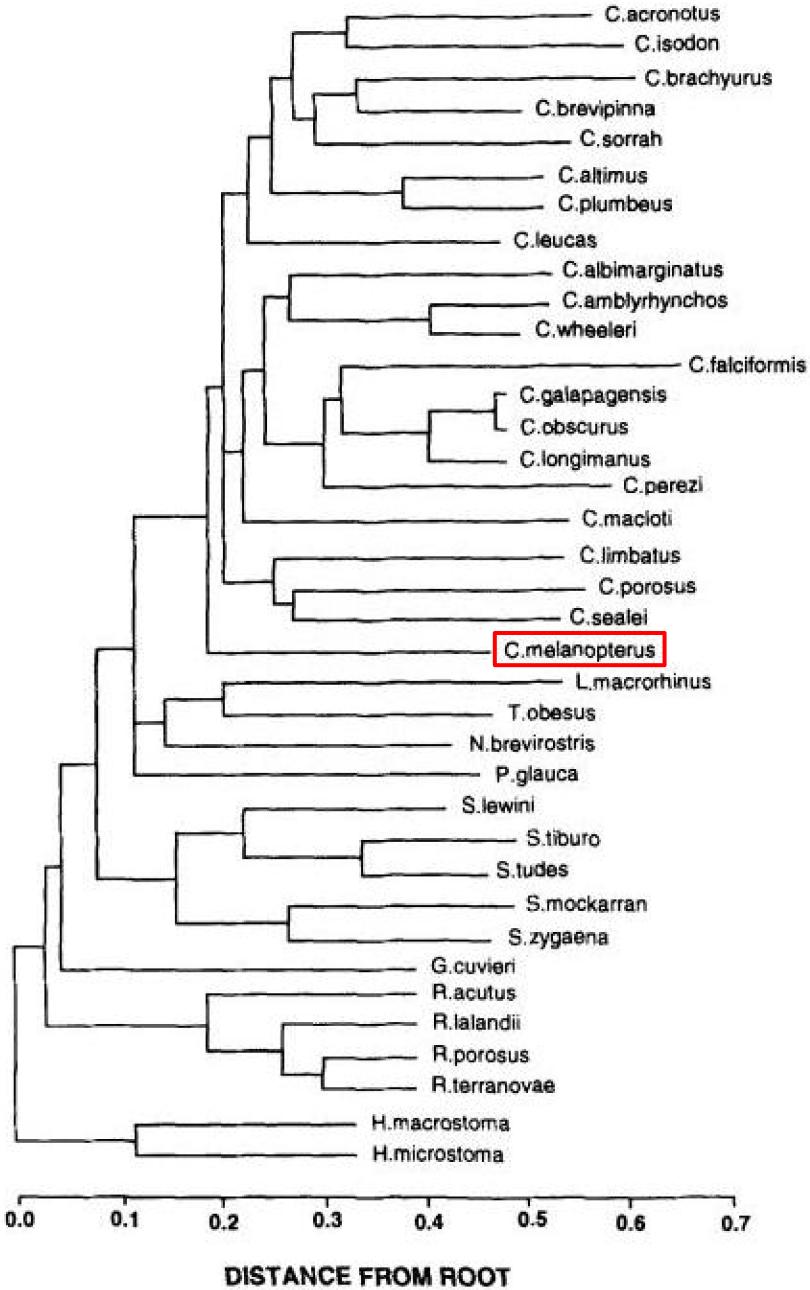 |
| Distance-Wagner tree obtained from Naylor (1992) [xiii]. The tree indicates that Carcharhinus is a monophyletic group, and places P. glauca in a sister clade. It was constructed according to the Cavalli-Sforza and Edwards chord distance. Hemigaleus microstoma and H. macrostoma were designated as a combined out-group. The analysis sampled tissue from 37 different species, and assayed for 17 gene loci which were subsequently used as character states. |
Taxonavigation
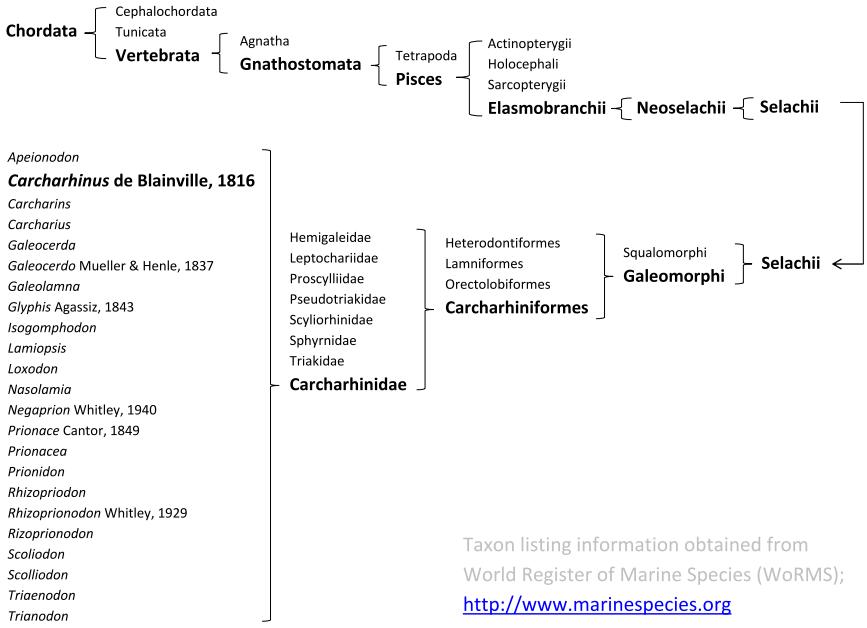 |
| Taxonavigation to Carcharhinus taxon level |
Designation as type species
This shark was first described by Jean René Constant Quoy and Joseph Paul Gaimard in 1824.Their paper initially classified this shark under the Carcharias taxon. However, later authors reclassified it under the Carcharhinus taxon. In 1962, melanopterus became the type species for the Carcharhinus classification (see article below). The holotype for this species is presently kept at the Museum National d'Histoire Naturelle, Paris (MNHN 1129, 590mm, immature male) [16].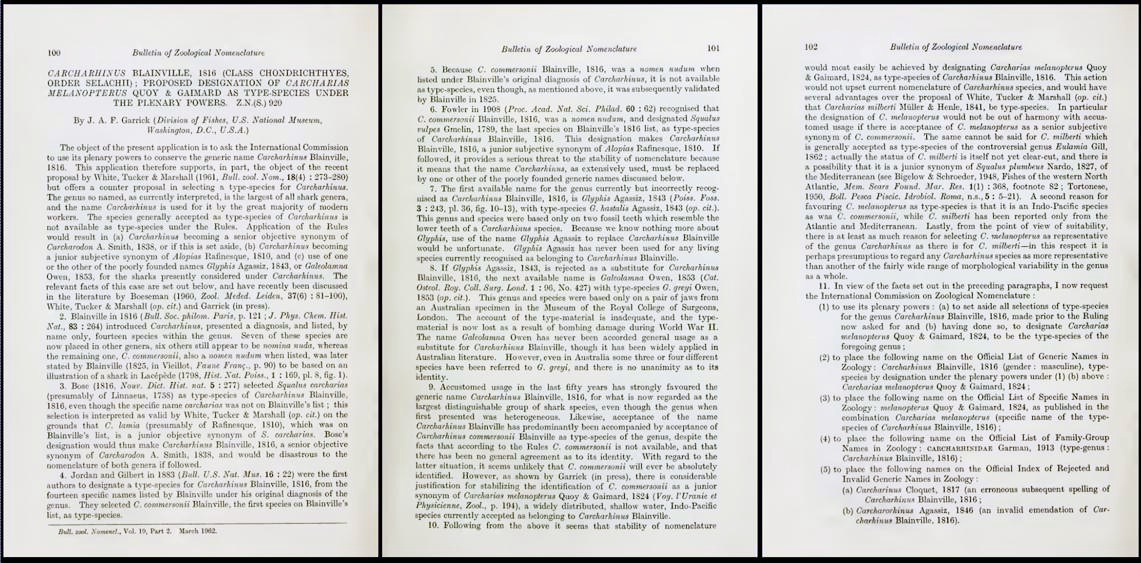 |
| Click on image to view full record at Biodiversity Heritage Library. http://www.biodiversitylibrary.org/ [xiv] |
References
- IUCN information from http://www.iucnredlist.org/details/summary/39375/0
- Information for sharks in Singapore from http://habitatnews.nus.edu.sg/guidebooks/marinefish/
- News report of a bull shark sighting from http://wildsingaporenews.blogspot.sg/2012/10/bull-shark-found-in-sembawang-dock.html#.UKmbx2c9Ff1
- Information on shark attack records from http://www.flmnh.ufl.edu/fish/sharks/statistics/GAttack/MapAsia.htm
- Food and Agriculture Organisation of the United Nations, (1999), Stefania Vannuccini, "Shark utilization, marketing and trade", http://www.fao.org/docrep/005/x3690e/x3690e1h.htm
- http://www.squidoo.com/hawaii-s-shark-whisperers-the-mano-ali-i
- http://www.flmnh.ufl.edu/fish/Gallery/Descript/blacktipreefshark/blacktipreefshark.html
- http://www.enchantedlearning.com/subjects/sharks/species/Blacktipreef.shtml
- Papastamatiou, Y.P., Friedlander, A.M., Caselle, J.E. & Lowe, C.G. (2010). "Long-term movement patterns and trophic ecology of blacktip reef sharks (Carcharhinus melanopterus) at Palmyra Atoll". Journal of Experimental Marine Biology and Ecology, 386(1-2): 94-102
- http://johannmourier.wordpress.com/actual-phd-shark-research-project/social-networks-in-sharks/
- http://www.visitsealife.com/explore-our-creatures/blacktip-reef-shark.aspx
- Mourier, J. & Planes, S. (2012). "Direct genetic evidence for reproductive philopatry and associated fine-scale migrations in female blacktip reef sharks (Carcharhinus melanopterus) in French Polynesia". Molecular Ecology, (in print)
- Dosay-Akbulut, M. (2008). "The phylogenetic relationship within the genus Carcharhinus". Molecular biology and genetics 331(7): 500-509
- Compagno, L.J.V. (1988). "Sharks of the order Carcharhiniformes". Princeton University Press. Princeton, NJ, USA.
- Naylor, G.J.P. (1992). "The phylogenetic relationships among requiem and hammerhead sharks: inferring phylogeny when thousands of equally most parsimonious trees result". Cladistics - the International Journal of the Willi Hennig Society, 8(4): 295-318
- http://fijisharkdive.com/shark-info/blacktip-reef-sharks
Images and videos
| [i] |
Mary O'Malley. http://www.sharksavers.org/en/blogs-news/community-voice/the-social-life-of-sharks/ |
| [ii] |
Karenne PP Tun. http://www.coralreef.nus.edu.sg/map.htm |
| [iii] |
http://www.pulauhantu.org/ |
| [iv] |
James K. http://sgn090608.blogspot.sg/ |
| [v] |
Ron Yeo. http://tidechaser.blogspot.sg/2010/05/blacktip-reef-sharks-trapped-in-drift.html |
| [vi] |
Ria Tan. http://www.wildsingapore.com/ |
| [vii] |
Food and Agriculture Organisation of the United Nations, (2005), Fabrizio Serena, "Field identification guide to the sharks and rays of the Mediterranean and Black Sea", http://www.fao.org/docrep/009/y5945e/y5945e00.htm |
| [viii] |
http://www.ryanphotographic.com/carcharhinidae.htm |
| [ix] |
Jennifer Goldner, NOAA (National Oceanic and Atmospheric Administration). http://teacheratsea.wordpress.com/tag/atlantic-sharpnose-shark/ |
| [x] |
http://iobis.org/mapper/?taxon=Carcharhinus%20melanopterus |
| [xi] |
http://www.underseaproductions.com/stock-footage/ |
| [xii] |
http://dsc.discovery.com/tv-shows/shark-week/videos/shark-mating.htm |
| [xiii] |
Naylor, G.J.P. (1992). "The phylogenetic relationships among requiem and hammerhead sharks: inferring phylogeny when thousands of equally most parsimonious trees result". Cladistics - the International Journal of the Willi Hennig Society, 8(4): 295-318. Image obtained from pg 300. |
| [xiv] |
Garrick, J.A.F. (1962) "Carcharhinus Blainville, 1816 (class Chondrichthyes, order Selachii); proposed designation of Carcharias melanopterus Quoy & Gaimard as type-species under the plenary powers". Bulletin of Zoological Nomenclature, 19: 100-102. Contributed by "Natural History Museum Library, London". Record found at http://www.biodiversitylibrary.org/item/44461#page/7/mode/1up |
Do feel free to contact me at jeromekok@gmail.com